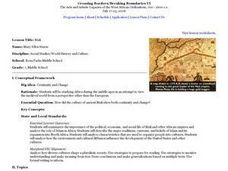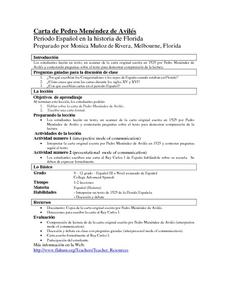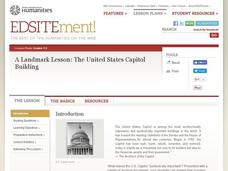Curated OER
Mali
Seventh graders begin the lesson plan by reading primary sources about the country of Mali. Using maps drawn in the past, they discuss what they can gather about the country from the map and how it has changed over time. They use a...
Curated OER
Census Detective
In this census worksheet, students look at primary sources of census's from Westminster's history and answer short answer questions about them. Students look at 4 sources and answer 27 questions total.
Curated OER
The king, the crown and the colonel: How did Thomas Blood try to steal the crown jewels in 1671?
Learners investigate Thomas Blood's attempt to steal the crown jewels. In this investigative lesson, students use four different primary sources to answer questions about how Thomas Blood tried to steal the crown jewels.
NPR
Chinese American Women Lesson Plan
The National Women's History Museum provides a plan designed to accompany their online CyberExhibit, Chinese American Women; a History of Resilience and Resistance. After examining a series of primary and secondary source documents,...
Curated OER
Carta de Pedro Menéndez de Avilés
Spanish learners peek back into history by reading a copy of an original letter written in the sixteenth century by Pedro Menéndez de Avilés. To show their comprehension, they respond to a series of provided questions. For writing...
Curated OER
A Landmark Lesson: The United States Capitol Building
Students study the events in American history that affected the US Capitol Building. They name activities that happen in and around the Capitol by looking at primary source documents that are available online.
US National Archives
WWII: Western Europe 1939-45 – Deception and Bluff
World War II left the British desperate for help in any form—including in the form of a magician! High schooler conduct research on Jasper Maskelyne, a stage magician who used his talents to deceive the Germans on the war front, before...
US National Archives
WWII: The Pacific 1939-45 – Iwo Jima
Of the images that have permeated history to define American courage, perseverance, and patriotism, the 1945 photograph of United States Marines raising the flag at Iwo Jima is one of the most well known. After researching the pivotal...
US National Archives
WWII: The Pacific 1939-45 – Japan and the Atom Bomb
Though the scientists who developed the atom bomb did not believe it should be used to end World War II, American President Harry S. Truman and British Prime Minister Winston Churchill were of like mind in their decision to drop the bomb...
ReadWriteThink
Captioning the Civil Rights Movement: Reading the Images, Writing the Words
Scholars boost their knowledge of the Civil Rights Movement with a lesson that challenges writers, readers, and historians to analyze primary sources and caption their observations. By way of reading, writing, discussion, independently,...
Curated OER
Sustained Resistance
Eleventh graders research events that led up to the Civil Rights movement using primary source documents that show attitudes about lynching.
Curated OER
Television Interviews Group 1
In this primary source analysis worksheet, students respond examine the linked resources and discuss their significance.
Curated OER
Television Interviews Group 2
In this primary source analysis worksheet, high schoolers respond examine the linked resources and discuss their significance.
Curated OER
Television Interviews Group 3
In this primary source analysis worksheet, learners respond examine the linked resources and discuss their significance.
Curated OER
Local Government: Caring for Your Community
Seventh graders investigate the role of local governments. In this government lesson, 7th graders examine historical photographs and determine what services are being performed in the photographs. Students research how the...
Curated OER
Migration
Students investigate migration issues. In this global studies lesson, students examine photographs that feature migrants from Canary Island and their movement to Spain by smugglers. Students view a PowerPoint presentation and discuss how...
Curated OER
Civil War Letters
Students put themselves in the shoes of American Civil War soldiers. In this Civil War lesson, students examine letters from the time period written by soldiers, edit the letters for grammatical errors, and then present the letters to...
Curated OER
What was Rationing?
Students analyze primary source documents to learn about World War II. In this world history activity, students use cheese and bread rationing coupons issued during the second World War to gather information about the documents and the...
Curated OER
African American Life during Jim Crow
Students examine Jim Crow laws using primary sources.
Curated OER
Confederation Comparison
Students compare/contrast through primary sources the Articles of Confederation in the United States to the Confederation Period in Canada. They summarize the successes and failures of each. In essence, they analyze the impact of...
Curated OER
With malice toward none, with charity for all: The life of Abraham Lincoln
Students research Abraham Lincoln in a variety of ways. In this Abraham Lincoln lesson plan, students use primary sources, vocabulary activities, books, and more to research and learn about Abraham Lincoln.
Curated OER
Chief Pontiac's Speech
In this primary source research worksheet, students examine th text of speech given by Chief Pontiac and respond to 4 short answer questions regarding its content.
Curated OER
The Stamp Act
In this teaching American history worksheet, young scholars examine a primary source document regarding the Stamp Act. Students discuss their impressions of the document.
Curated OER
Transcription of the Virginia Declaration
In this teaching primary resources worksheet, students read a transcription of the Virgina Declaration . Students read the excerpt and discuss its significance.

























